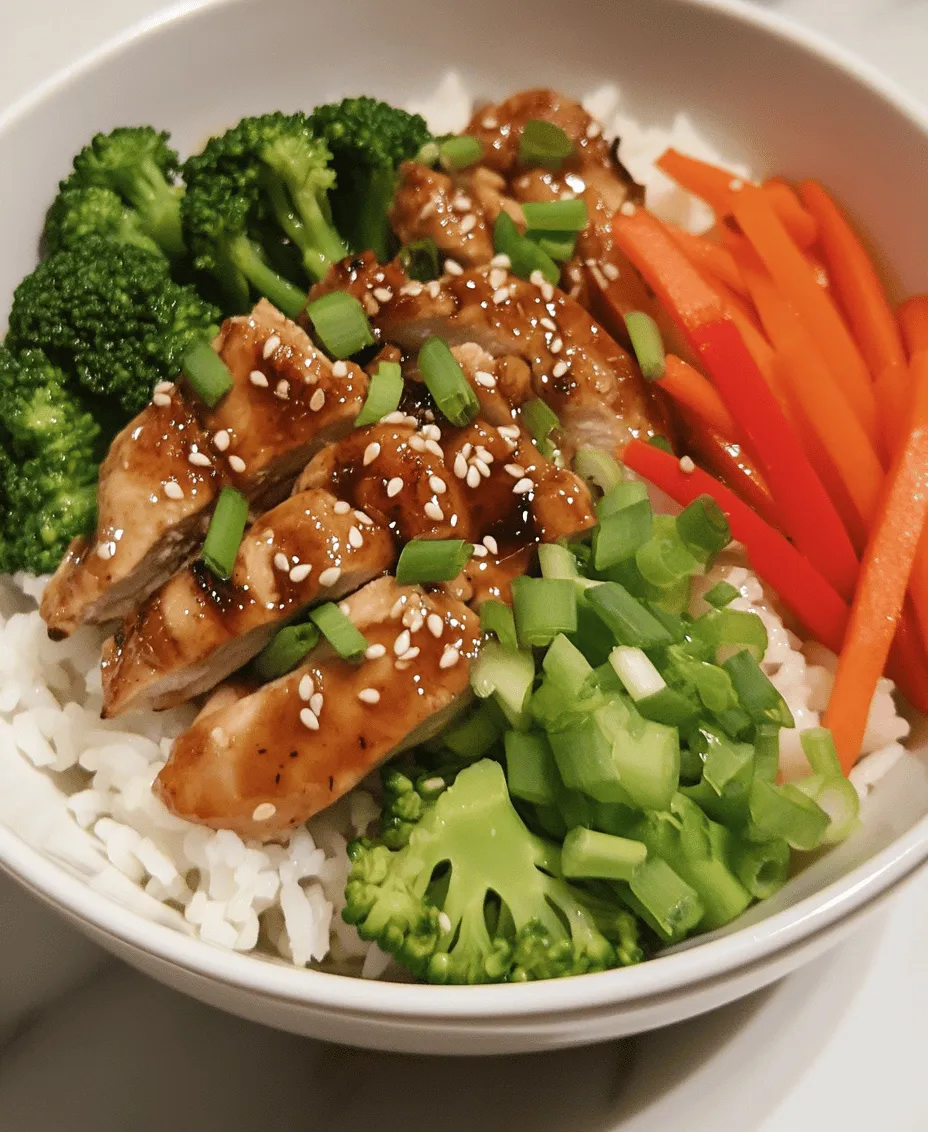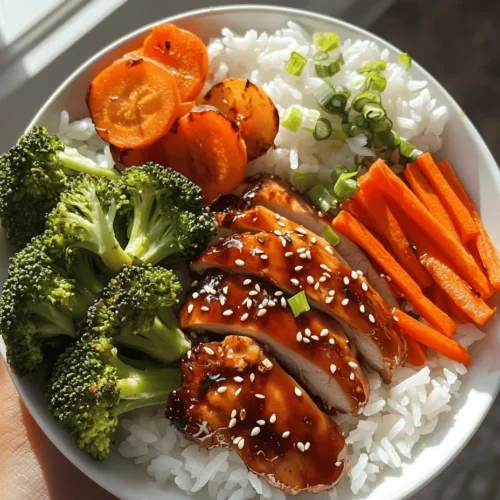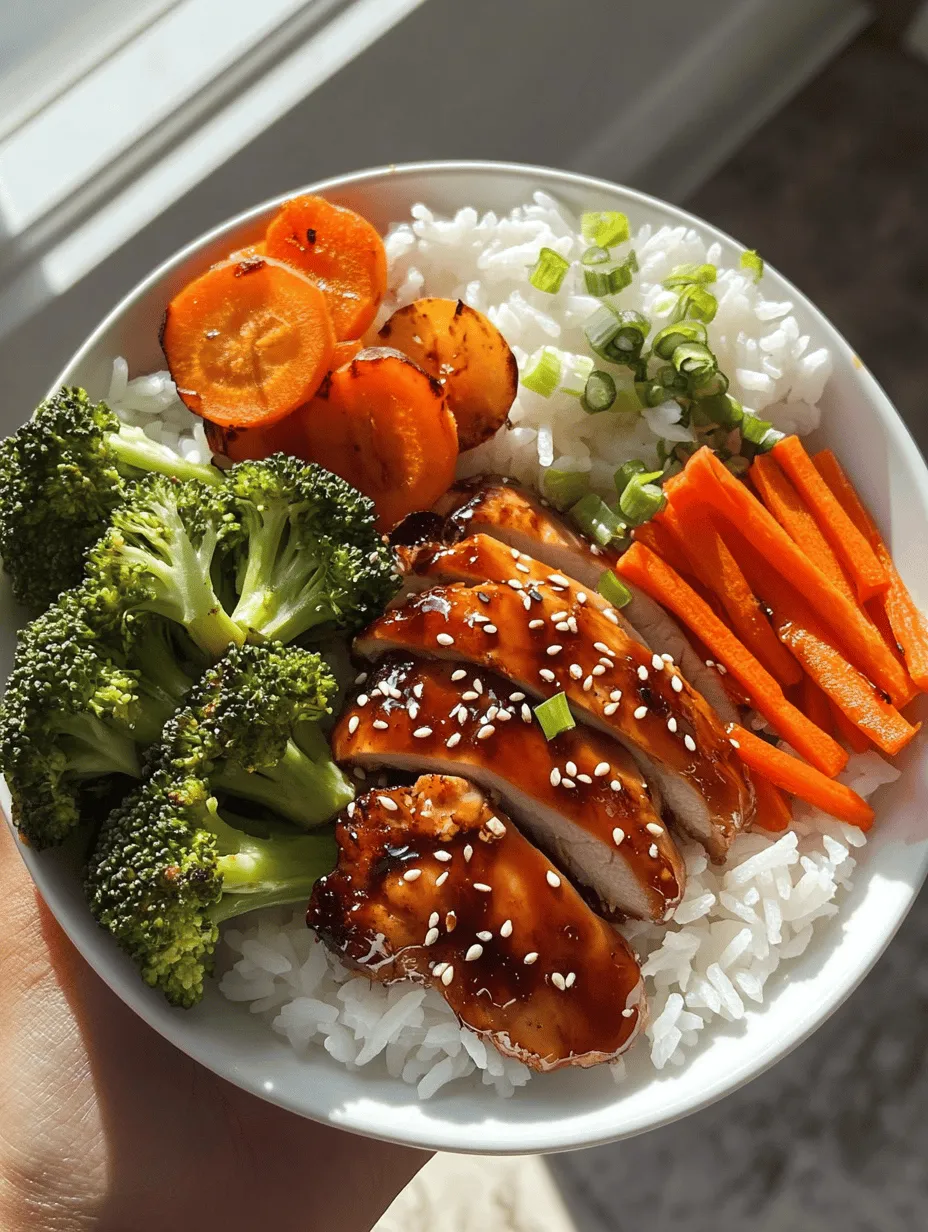Introduction
The Teriyaki Chicken Rice Bowl is a delightful culinary creation that combines tender chicken, vibrant vegetables, and a rich, savory sauce, all served over a bed of fluffy rice. This dish has gained immense popularity not only for its mouthwatering flavors but also for its versatility and ease of preparation. With roots deeply embedded in Japanese cuisine, teriyaki has transcended cultural boundaries, becoming a beloved staple in kitchens around the world. Whether enjoyed at a bustling restaurant or crafted at home, the Teriyaki Chicken Rice Bowl is a meal that appeals to food enthusiasts of all ages.
In this article, we will delve into the fascinating world of teriyaki, exploring its origins and the unique sauce that elevates this dish. We will guide you through the essential ingredients that contribute to the perfect Teriyaki Chicken Rice Bowl, detailing their nutritional benefits and the importance of using fresh produce. Additionally, we will provide a comprehensive overview of the preparation steps, ensuring that you achieve the ideal balance of flavors and textures. By the end of this article, you will have everything you need to create this delicious dish in your own kitchen.
Understanding Teriyaki: The Sauce That Elevates Dishes
Definition and Origins of Teriyaki Sauce
Teriyaki, which translates to “glossy grill” in Japanese, refers to a cooking technique in which food is grilled or broiled with a glaze of soy sauce, sake, and sugar. The origins of teriyaki can be traced back to Japan in the early 17th century, where it was primarily used to prepare fish. Over time, the technique evolved to include various meats and vegetables, gaining popularity both in Japan and internationally. Today, teriyaki sauce has become synonymous with a sweet and savory flavor profile that enhances a multitude of dishes beyond its traditional roots.
Key Ingredients That Make Teriyaki Sauce Special
At the heart of any great teriyaki dish lies its sauce, which is typically made from a harmonious blend of soy sauce, mirin (a sweet rice wine), sake, and sugar. Some variations may include ginger, garlic, or sesame oil to add depth and complexity to the flavor. The soy sauce provides a rich umami base, while mirin and sugar contribute sweetness that balances the saltiness. The inclusion of ginger and garlic introduces a warm, aromatic touch that elevates the overall taste experience.
Health Benefits Associated with the Components of Teriyaki Sauce
While teriyaki sauce is often associated with indulgent flavors, it can also offer several health benefits when made thoughtfully. Soy sauce, for instance, is a source of protein and contains antioxidants that may help combat oxidative stress. Mirin is lower in alcohol than other cooking wines, making it a safer option for family meals. Additionally, incorporating fresh ginger and garlic can enhance your immune system and provide anti-inflammatory benefits. When prepared at home, you can control the sugar content and use low-sodium soy sauce, making it a healthier alternative to store-bought options.
Ingredients Breakdown: What You Need for the Best Teriyaki Chicken Rice Bowl
To create a delectable Teriyaki Chicken Rice Bowl, you’ll need a selection of fresh ingredients that work in harmony to deliver flavor and nutrition. Below is a detailed breakdown of each ingredient essential for this recipe.
Key Ingredients
– Chicken Breast: The star of the dish, chicken breast is favored for its lean protein content and mild flavor, which absorbs the teriyaki sauce beautifully. Opt for high-quality, organic chicken for the best results.
– Rice: Short-grain or medium-grain white rice is traditionally used for its sticky texture, which holds the dish together. Brown rice can be used as a healthier alternative, providing more fiber and nutrients.
– Soy Sauce: A fundamental component of teriyaki sauce, soy sauce adds depth and umami flavor. Choose low-sodium soy sauce if you’re watching your salt intake.
– Mirin: This sweet rice wine adds a unique sweetness to the sauce. If you prefer a non-alcoholic version, you can substitute mirin with a mixture of white wine vinegar and sugar.
– Fresh Vegetables: A colorful array of vegetables such as broccoli, bell peppers, and snap peas not only enhances the visual appeal of the dish but also adds essential vitamins and minerals. Fresh produce ensures maximum flavor and nutrition.
– Ginger and Garlic: These aromatics are crucial for building flavor in both the chicken and the teriyaki sauce. Fresh ginger offers a zesty kick, while garlic provides warmth and richness.
– Sesame Seeds: Used as a garnish, toasted sesame seeds add a nutty flavor and a delightful crunch to the finished bowl.
Importance of Using Fresh Vegetables and High-Quality Chicken
When preparing a Teriyaki Chicken Rice Bowl, the quality of your ingredients can significantly impact the final dish. Fresh vegetables not only taste better but also retain their nutrients, contributing to a healthier meal. In contrast, wilted or stale vegetables can detract from the dish’s overall appeal. Similarly, using high-quality chicken ensures that you are consuming a protein source that is free from hormones and antibiotics, providing better flavor and nutrition.
Nutritional Benefits of Key Ingredients
Each ingredient in the Teriyaki Chicken Rice Bowl contributes to a well-rounded meal. Chicken breast is an excellent source of lean protein, essential for muscle growth and repair. Rice provides carbohydrates for energy, while vegetables like broccoli and bell peppers are packed with vitamins A and C, antioxidants, and dietary fiber. Ginger and garlic not only enhance flavor but also possess anti-inflammatory and immune-boosting properties. By incorporating these ingredients, you can create a dish that is not only delicious but also nourishing.
Preparation Steps: Crafting Your Teriyaki Chicken Rice Bowl
Creating a Teriyaki Chicken Rice Bowl is a straightforward process that allows home cooks to enjoy the flavors of this Japanese classic in the comfort of their own kitchen. Below, we outline the essential preparation steps to guide you through the cooking process.
Overview of the Cooking Process
1. Marinate the Chicken: To infuse the chicken with the rich flavors of teriyaki, it is essential to marinate it before cooking. A simple marinade of soy sauce, mirin, ginger, and garlic will do the trick.
2. Cook the Rice: Prepare the rice according to package instructions, ensuring that it achieves the desired fluffy texture.
3. Prepare the Vegetables: While the rice cooks, chop and prepare your chosen vegetables, ensuring they are fresh and vibrant.
4. Cook the Chicken: Sear the marinated chicken in a hot skillet until it is golden brown and cooked through.
5. Add Vegetables: Once the chicken is nearly done, add the prepared vegetables to the pan, allowing them to cook slightly while retaining their crunch.
6. Combine with Teriyaki Sauce: Pour the homemade teriyaki sauce over the chicken and vegetables, stirring to coat everything evenly.
7. Serve: Once the sauce has thickened slightly, serve the teriyaki chicken and vegetables over a bed of rice, garnishing with sesame seeds.
Explanation of the Significance of Each Step in the Recipe
Each step in the preparation process plays a critical role in achieving the best flavor and texture for your Teriyaki Chicken Rice Bowl. Marinating the chicken not only enhances its taste but also helps to tenderize the meat. Cooking the rice properly ensures that each grain is separate and fluffy, providing the perfect base for the dish. By adding the vegetables towards the end of the cooking process, you maintain their vibrant color and crispness, contributing to both the visual appeal and nutritional value of the meal.
Importance of Timing and Temperature Control in Cooking Chicken and Vegetables
Timing and temperature control are essential when cooking the chicken and vegetables for your Teriyaki Chicken Rice Bowl. Cooking the chicken over medium-high heat allows for a delicious sear while ensuring that it remains juicy inside. Overcooking can lead to dry, tough meat. Similarly, when adding vegetables, it’s crucial to cook them just enough to soften slightly while keeping their bright colors and crunchiness. This balance ensures that every component of the dish contributes to a delightful experience.
With these foundational insights into the Teriyaki Chicken Rice Bowl, we are well on our way to crafting this delicious dish. In the next section, we will focus on making the teriyaki sauce, highlighting its preparation and variations to suit different tastes. Stay tuned for a deeper dive into achieving the perfect balance of flavors in this iconic sauce!

Techniques for Cooking Chicken Thighs to Ensure Tenderness and Flavor
When preparing the perfect Teriyaki Chicken Rice Bowl, the chicken thighs you choose play a pivotal role in the dish’s overall flavor and texture. Chicken thighs are often preferred over chicken breasts in teriyaki dishes due to their higher fat content, which translates to juiciness and richer flavor. To achieve the best results, consider the following techniques:
1. Marination: Marinating chicken thighs in the teriyaki sauce not only infuses them with flavor but also helps in tenderizing the meat. Aim for at least 30 minutes, but for optimal results, marinate overnight in the refrigerator. This allows the flavors to penetrate deeply.
2. Proper Cooking Temperature: Cooking chicken thighs at a medium-high temperature for a shorter period can help prevent them from drying out. Use a meat thermometer to ensure they reach an internal temperature of 165°F (74°C).
3. Resting Period: After cooking, allow the chicken thighs to rest for about five minutes before slicing. This helps the juices redistribute, ensuring each bite is moist and flavorful.
Discussion on the Choice of Oils and Their Impact on the Dish
The type of oil you use can significantly affect the flavor profile and health aspects of your Teriyaki Chicken Rice Bowl. Here are some oil options to consider:
– Sesame Oil: This oil not only adds a distinctive nutty flavor but also enhances the authenticity of Asian dishes. Use it sparingly as a finishing oil or in your marinade to avoid overpowering the other flavors.
– Canola or Vegetable Oil: These oils have a high smoke point, making them ideal for stir-frying. They provide a neutral base that allows the teriyaki sauce’s flavors to shine through.
– Olive Oil: While not traditional in Asian cuisine, olive oil can be used if you prefer its flavor. Its lower smoke point makes it less ideal for high-heat cooking, so use it carefully.
Choosing the right oil can elevate your dish, providing both flavor and a healthy cooking medium.
Importance of Browning the Chicken for Depth of Flavor
Browning the chicken thighs is a crucial step in developing deep, rich flavors in your Teriyaki Chicken Rice Bowl. The Maillard reaction, which occurs when proteins and sugars in the meat are exposed to high heat, creates complex flavors and a pleasing texture. To achieve perfect browning:
1. Preheat Your Pan: Ensure your skillet or wok is hot before adding the oil and chicken. A hot surface will sear the meat, creating a golden-brown crust.
2. Avoid Overcrowding: Cook the chicken in batches if necessary. Overcrowding the pan lowers the temperature and prevents proper browning, leading to steaming rather than searing.
3. Patience is Key: Allow the chicken to sear undisturbed for a few minutes before flipping. This ensures that a nice crust forms, which enhances the overall flavor of the dish.
Incorporating Vegetables: A Nutritional Boost
Adding vegetables to your Teriyaki Chicken Rice Bowl not only enhances its nutritional profile but also provides vibrant color and texture. Here’s how to effectively incorporate vegetables:
Benefits of Adding Vegetables to the Dish
Vegetables are an essential component of a balanced diet, providing vitamins, minerals, and fiber. Incorporating a variety of vegetables into your teriyaki bowl can help:
– Increase your intake of essential nutrients.
– Add crunch and freshness to the dish.
– Balance the flavors and textures, making each bite more satisfying.
Suggestions for Alternative Vegetables to Customize the Recipe
While traditional teriyaki dishes often include bell peppers and broccoli, feel free to get creative. Some excellent alternatives include:
– Snow Peas: Their sweet, crisp texture pairs well with the savory teriyaki sauce.
– Carrots: Thinly sliced or julienned, they add sweetness and a pop of color.
– Zucchini: Sliced into half-moons, zucchini cooks quickly and absorbs flavors beautifully.
– Mushrooms: Shiitake or button mushrooms add an earthy flavor that complements the dish.
How to Properly Stir-Fry Vegetables to Retain Their Nutrients and Crunch
To ensure your vegetables retain their nutrients and crunch, follow these stir-frying tips:
1. Prepare Ahead: Cut all vegetables into uniform sizes to ensure even cooking.
2. High Heat: Use high heat to cook the vegetables quickly, which helps maintain their vibrant colors and crisp textures.
3. Timing: Add vegetables that require longer cooking times (like carrots) first, followed by quicker-cooking options (like bell peppers and snow peas).
4. Minimal Water: Avoid adding too much water or sauce during cooking, as this can lead to steaming rather than stir-frying.
Bringing It All Together: Combining Ingredients for Maximum Flavor
Once your chicken and vegetables are perfectly cooked, it’s time to bring everything together for that signature teriyaki experience.
Tips on How to Combine the Chicken, Vegetables, and Sauce
– Mixing: Once the chicken is browned and cooked through, add the vegetables directly to the skillet. Toss them together for a minute or so to combine the flavors.
– Sauce Addition: Pour in the teriyaki sauce and stir to coat all the ingredients evenly. The heat will help the sauce adhere to the chicken and vegetables.
The Significance of Letting the Sauce Simmer for Thickening
Letting the teriyaki sauce simmer is crucial for thickening and intensifying the flavors. Allow it to bubble gently for about 2-3 minutes, which will create a glossy coating on your chicken and vegetables, enhancing the dish’s visual appeal and taste.
Serving Suggestions: How to Present Your Teriyaki Chicken Rice Bowl
Presentation is key to making your Teriyaki Chicken Rice Bowl as appealing as it is delicious. Here are some ideas to enhance your serving style:
Ideas for Garnishing and Enhancing Presentation
1. Sesame Seeds: Sprinkle toasted sesame seeds over the top for a nutty flavor and attractive texture.
2. Green Onions: Finely sliced green onions add a fresh, mild onion flavor and a pop of color.
3. Pickled Ginger: A small serving of pickled ginger on the side can enhance the dish with a tangy contrast.
4. Cilantro or Basil: Fresh herbs can add brightness and a fresh aroma.
Pairing Options That Complement the Rice Bowl
To elevate your meal, consider pairing your Teriyaki Chicken Rice Bowl with:
– Miso Soup: A warm and comforting addition that complements the flavors of the bowl.
– Edamame: These protein-rich soybeans make a nutritious side dish.
– Japanese Pickles: Their acidity can balance the sweetness of the teriyaki sauce.
Discussion on Portion Sizes and Serving Styles
For an ideal serving size, aim for about 1 cup of cooked rice, topped with ½ cup of teriyaki chicken and vegetables. This portion strikes a balance between being filling and allowing room for side dishes. Consider serving in individual bowls for a cozy presentation that encourages sharing and conversation.
Nutritional Information: Understanding the Health Benefits
When enjoying your Teriyaki Chicken Rice Bowl, it’s important to consider its nutritional composition:
Breakdown of Calories, Proteins, Fats, and Carbohydrates Per Serving
A typical serving (with 1 cup of rice, ½ cup of chicken, and vegetables) contains approximately:
– Calories: 550-600
– Protein: 30-35 grams
– Fat: 15-20 grams
– Carbohydrates: 70-80 grams
These values can vary based on ingredient choices and portion sizes, but they highlight the dish’s balanced nutrition.
Discussion on How This Dish Fits Into a Balanced Diet
The Teriyaki Chicken Rice Bowl offers a well-rounded meal that includes proteins from chicken, carbohydrates from rice, and a variety of vitamins and minerals from added vegetables. It can easily fit into a balanced diet, especially when you opt for brown rice or cauliflower rice for a lower-carb alternative.
Addressing Common Dietary Concerns (e.g., Gluten-Free Options)
For those with gluten sensitivities, gluten-free teriyaki sauce options are available at most grocery stores. Simply substitute regular soy sauce with tamari or coconut aminos to enjoy the dish without compromising your dietary needs.
Conclusion
The Teriyaki Chicken Rice Bowl is a delightful fusion of flavors, textures, and colors, making it a favorite in many households. With its simple preparation and the ability to customize with various vegetables, this dish is as versatile as it is delicious.
By following the techniques outlined for cooking tender chicken, selecting the right oils, and incorporating vibrant vegetables, you can create a meal that is not only satisfying but also nutritious. The process of preparing the teriyaki sauce and allowing it to simmer enriches the overall experience, bringing all the elements together in harmony.
We encourage you to try this recipe and experience the delightful flavors for yourself. Homemade meals like this one not only provide comfort but also open the door to exploring the rich traditions of Asian cuisine. Enjoy the journey of cooking and the joy of sharing a delicious meal with your loved ones!



